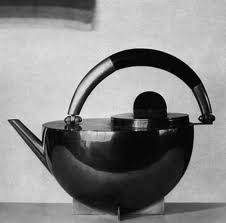The Bauhaus was a school in Germany founded by an architect, Walter Gropius in 1919. At Bauhaus students received theoretical and practical training in the fine arts such as ceramics, metalwork, typography and furniture making. Students learnt to combine art and craft with new technologies in order to create pieces that were practical and aesthetically pleasing. Designs associated with the Bauhaus were simplified forms, rational and functional. It was one of the first art schools to teach its students modern design.
Influenced by De Stijl, Gropius wanted to create a new artistic style as he had argued that with the end of the war a new period had begun. He aimed to develop a curriculum that would create artists and designers that would create pieces appropriate to a new system of living, objects that would be functional and meet societies demands. It aimed to create things that would be suitable for mass production by taking on simplistic forms that could be produced quickly and efficiently. In order to do this they developed a clean, simple style using abstract geometric forms. Objects being designed to have economical use of space, material, time and money, being functional whilst still retaining an aesthetic design.
Teaching at the Bauhaus was forward thinking as the school employed many leading European artists and architects who were highly influential. During this time the De Stijl movement was particularly influential and in 1922 it’s founder Theo Van Doesburg taught a course at the Bauhaus, advocating the use of primary colours, rectangular forms and straight lines. These principles were reflected in much of the Bauhaus output after that.
The Bauhaus contributed greatly to modern furniture design. Architect and designer Marcel Breuer both studied and taught at the Bauhaus during the 1920’s, he was appointed head of the school’s carpentry workshop. During his time at the Bauhaus Breuer experimented with steel to create lightweight furnishings pursuing the Bauhaus manufacturing techniques and interest in industrial materials. This led to the design of Breuers iconic Wassily chair, marking a new era in modern furniture.
Typography was initially not a priority at the Bauhaus, however the Bauhaus’ influence in typography still remains today. It became increasingly more important under the teachings of László Moholy-Nagy. It became to be considered as a means of artistic expression whilst becoming connected to corporate identity and advertising. A poster was created for the school that caused great interest in its unique typeset and design. The Bauhaus typeset was clear, using geometric shapes and vibrant colours, it was strong and universal. The Bauhaus style typography is still used in modern day designs and posters.
The Nazis closed the Bauhaus in 1933. Many of the artists immigrated to America to escape world war 2, where they had great success. The teachings and work of the Bauhaus lecturers influenced many young designers and architects in the united states as Walter Gropius went to Harvard whilst Marcel Breuer taught at Yale and Moholy-Nagy established the New Bauhaus in Chicago. The Bauhaus’ principles and teaching became known world wide and dominated art and architecture for decades.




